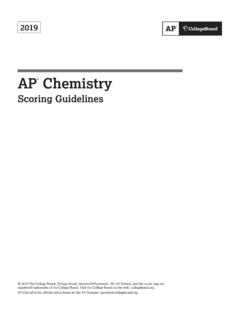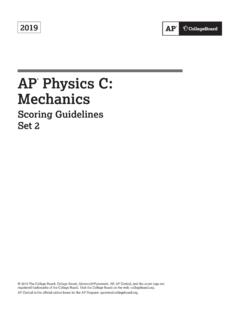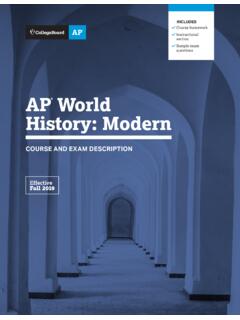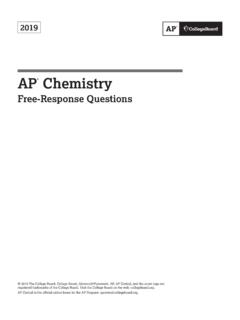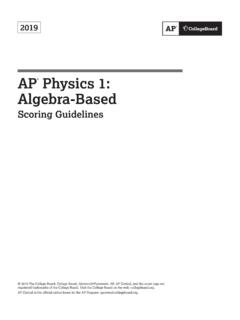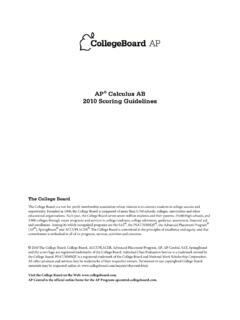Transcription of AP Psychology Scoring Guidelines from the 2019 Exam ...
1 2019. AP Psychology . Scoring Guidelines Set 1. 2019 The College Board. College Board, Advanced Placement, AP, AP Central, and the acorn logo are registered trademarks of the College Board. Visit the College Board on the web: AP Central is the official online home for the AP Program: AP Psychology . 2019 Scoring Guidelines . Question 1. A psychologist conducted a study at her home during an annual activity of children wearing masks and going door-to-door receiving candy. Some of the children arrived alone, while others arrived in a group. Over the course of the night, the psychologist asked half of the children to remove their masks when they arrived at her door. The remaining half kept their masks on. The psychologist told every child to take only one piece of candy. She then went inside the house, leaving the bowl of candy outside. This gave children the opportunity to take additional candy.
2 The psychologist measured the percentage of children who took additional candy. The psychologist's hypotheses were that children would take more candy when they were alone and that children would take more candy when they were masked. The results are shown in the graph below; assume all differences are significant. A. Identify the operational definition of the dependent variable in this study. B. Explain how the data support or do not support each of the psychologist's hypotheses. C. Explain why the psychologist cannot generalize her findings to all children. D. Explain why the study is not a naturalistic observation. E. Explain how each of the following might have played a role in the children's behavior. Modeling Deindividuation Lawrence Kohlberg's preconventional stage 2019 The College Board. Visit the College Board on the web: AP Psychology .
3 2019 Scoring Guidelines . Question 1 (continued). General Considerations 1. Answers should be presented in sentences and must be cogent enough for the meaning of the response to come through. Spelling and grammatical mistakes do not reduce the score of a response, but spelling must be close enough that the reader is convinced of the word. 2. Do not score any notes made on the question section of the booklet. Score only what has been written in the blanks provided in the booklet. 3. Definitions alone will not score, but they may be used to enhance the application. 4. Within a point, a student will not be penalized for misinformation unless it directly contradicts correct information that would otherwise have scored a point. A correct application with an incorrect definition is not considered a direct contradiction and should score the point.
4 5. Rubric examples provided for each point are not to be considered exhaustive. 6. Responses that simply parrot or repeat the terms from the question will not score. 7. A response can score a point only if it clearly conveys what part of the question is being answered. It is possible to infer what part of the question is being answered if it is consistent with the order of the question. Point 1 (A): Operational definition of dependent variable Responses must indicate that the operational definition of the dependent variable is the percentage/number of children who took additional/extra pieces of candy. Score: Whether the child/children took additional candy.. Do NOT score operational definitions of the independent variable (mask/no mask, solo/group). Do NOT score references to some candy, which does not specify additional/extra pieces. Point 2 (B): Data support Responses must indicate t hat the data do not support the hypothesis that children would take more candy when alone (hypothesis 1) AND that the data support the hypothesis that children would take more candy when masked (hypothesis 2).
5 Point 3 (C): Generalizability Responses must indicate that the psychologist cannot generalize because of sampling bias, OR there was no random sampling/selection procedure, OR the psychologist only used children in her neighborhood. Score examples to illustrate that the sample was not representative of the population of children. Do NOT score random assignment alone. Do NOT score insufficient sample size alone. Point 4 (D): Naturalistic observation Responses must indicate that the study is not naturalistic observation because the researcher is interacting with subjects OR is manipulating a variable. Score any relevant example of the researcher interacting with the children. Score experiment or experimentation as an indication of manipulating a variable. 2019 The College Board. Visit the College Board on the web: AP Psychology . 2019 Scoring Guidelines .
6 Question 1 (continued). Point 5 (E): Modeling Responses must indicate that in reference to taking candy, children imitated what they saw others do. Score references to modeling that occurs outside of the situation and that influences taking candy ( , parents modeled stealing in the past, leading to children taking more candy). Do NOT score references to children's obedience. Point 6: Deindividuation Responses must indicate that because deindividuated children felt anonymous, they were more likely to take extra candy. Score responses that indicate taking extra candy results from a feeling of anonymity, a loss in sense of self/identity, or a loss in self-awareness or individuality. Do NOT score descriptions of diffusion of responsibility ( feel less responsible ). Point 7: Lawrence Kohlberg's preconventional stage Responses must indicate that taking candy is linked to the children's narrow self-interest in gaining a tangible reward or avoiding punishment.
7 Do NOT score references to conventional (compliance or obedience) or post-conventional (abstract). stages. 2019 The College Board. Visit the College Board on the web: AP Psychology . 2019 Scoring Guidelines . Question 2. As a senior in high school, Ludy worked as an assistant to the children's librarian in his town library. He enjoyed shelving the books in the library because he was able to work alone and focus on his task. Although the library was normally a quiet place, sometimes the children's section became quite noisy when groups of children visited. After working in an unfulfilling desk job for 30 years, Ludy recalls how much he enjoyed working at the library and decides to go back and work as a volunteer creating new programs for disadvantaged children. Describe how each of the following concepts relates to Ludy's return to working at the library.
8 Crystallized intelligence Altruism Big Five trait of extraversion Broca's area Self-efficacy Episodic memory Self-actualization General Considerations 1. Answers should be presented in sentences and must be cogent enough for the meaning of the response to come through. Spelling and grammatical mistakes do not reduce the score of a response, but spelling must be close enough that the reader is convinced of the word. 2. Do not score any notes made on the question section of the booklet. Score only what has been written in the blanks provided in the booklet. 3. Definitions alone will not score, but they may be used to enhance the application. 4. Within a point, a student will not be penalized for misinformation unless it directly contradicts correct information that would otherwise have scored a point. A correct application with an incorrect definition is not considered a direct contradiction and should score the point.
9 5. Rubric examples provided for each point are not to be considered exhaustive. 6. Responses that simply parrot or repeat the terms from the question will not score. 7. A response can score a point only if it clearly conveys what part of the question is being answered. It is possible to infer what part of the question is being answered if it is consistent with the order of the question. 2019 The College Board. Visit the College Board on the web: AP Psychology . 2019 Scoring Guidelines . Question 2 (continued). Point 1: Crystallized intelligence Responses must indicate how acquired knowledge (facts, general information, or vocabulary), or lack thereof, relates to Ludy's return to working at the library. Score: Ludy's ability to recall the Dewey Decimal System will help in his return.. Score: Ludy's lack of knowledge of current library practices impedes his success.
10 Score: As Ludy reads books to the children it adds to their understanding of the world.. Point 2: Altruism Responses must describe how helping for unselfish reasons is related to Ludy's return to working at the library. Score: Ludy is helping at the library without expectation of getting something in return.. Score: If Ludy is low in altruism he might be returning for selfish reasons.. Score: Ludy is demonstrating altruism by volunteering.. Score: Ludy inspires the children to donate their time doing community service.. Do NOT score: Ludy is volunteering because he wants to put it on his resume.. Point 3: Big Five trait of extraversion Responses must indicate how an aspect of extraversion ( , being outgoing, sociable, not shy, friendly, assertive, or draws energy from others) is related to Ludy's return to working at the library. Score: Ludy is outgoing and enjoys working with the children.
